鲁教版六上 Unit 7 Where’s my backpack(全单元学案+习题)
文档属性
| 名称 | 鲁教版六上 Unit 7 Where’s my backpack(全单元学案+习题) | 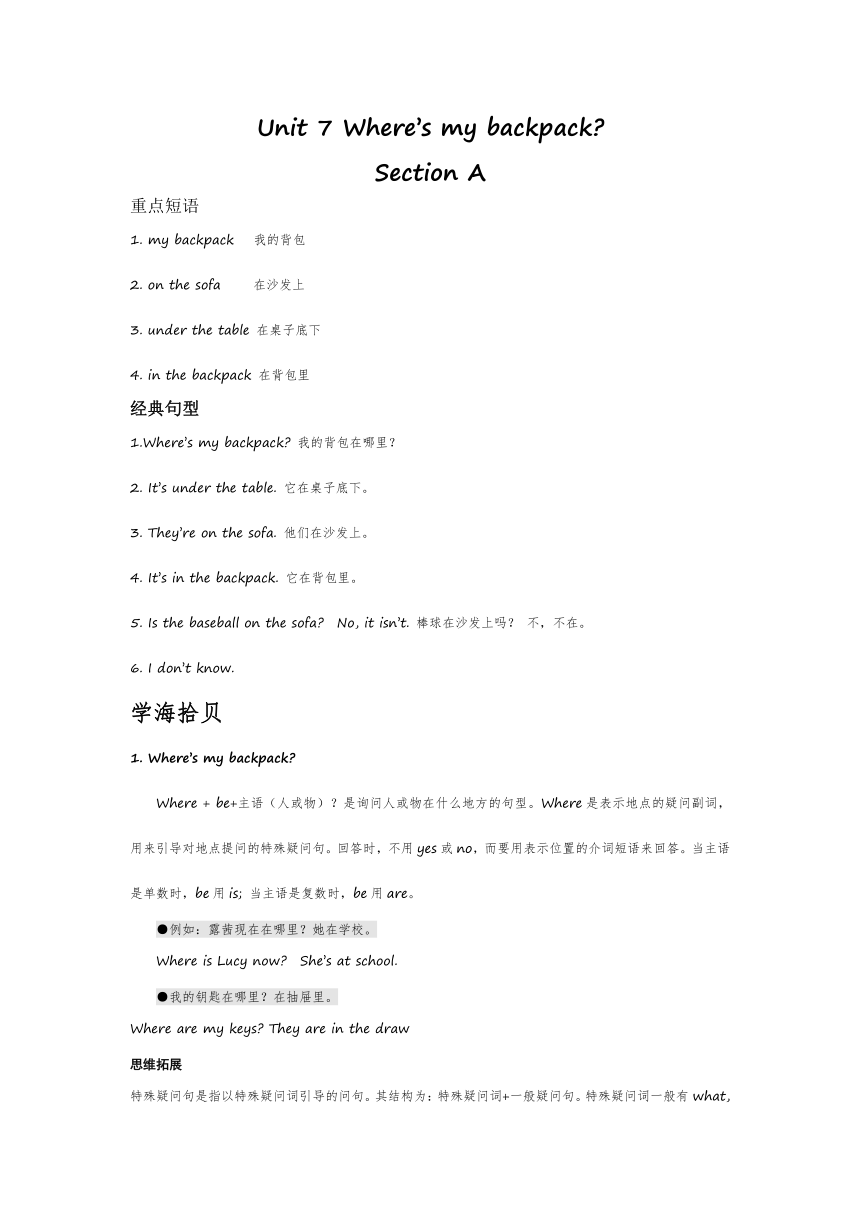 | |
| 格式 | zip | ||
| 文件大小 | 27.9KB | ||
| 资源类型 | 教案 | ||
| 版本资源 | 鲁教版(五四学制) | ||
| 科目 | 英语 | ||
| 更新时间 | 2014-01-26 23:37:29 | ||
图片预览

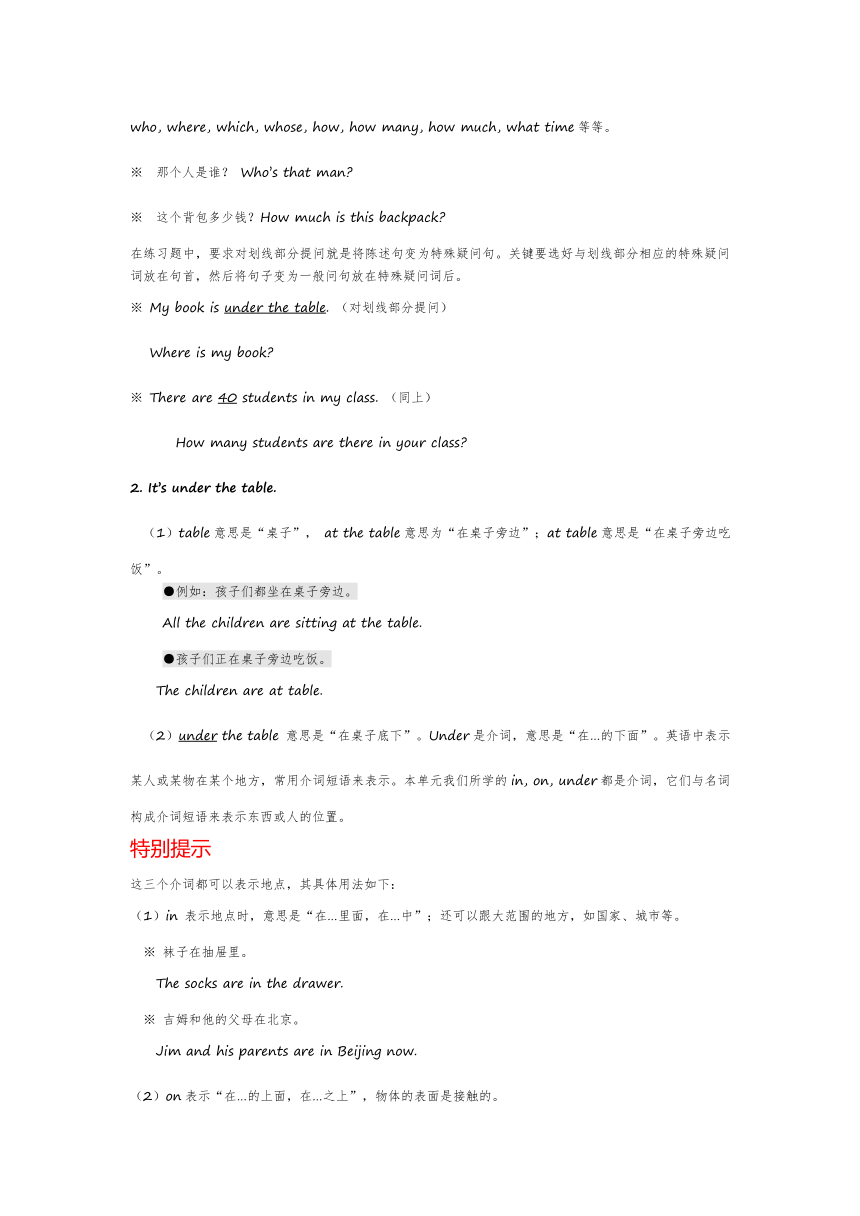
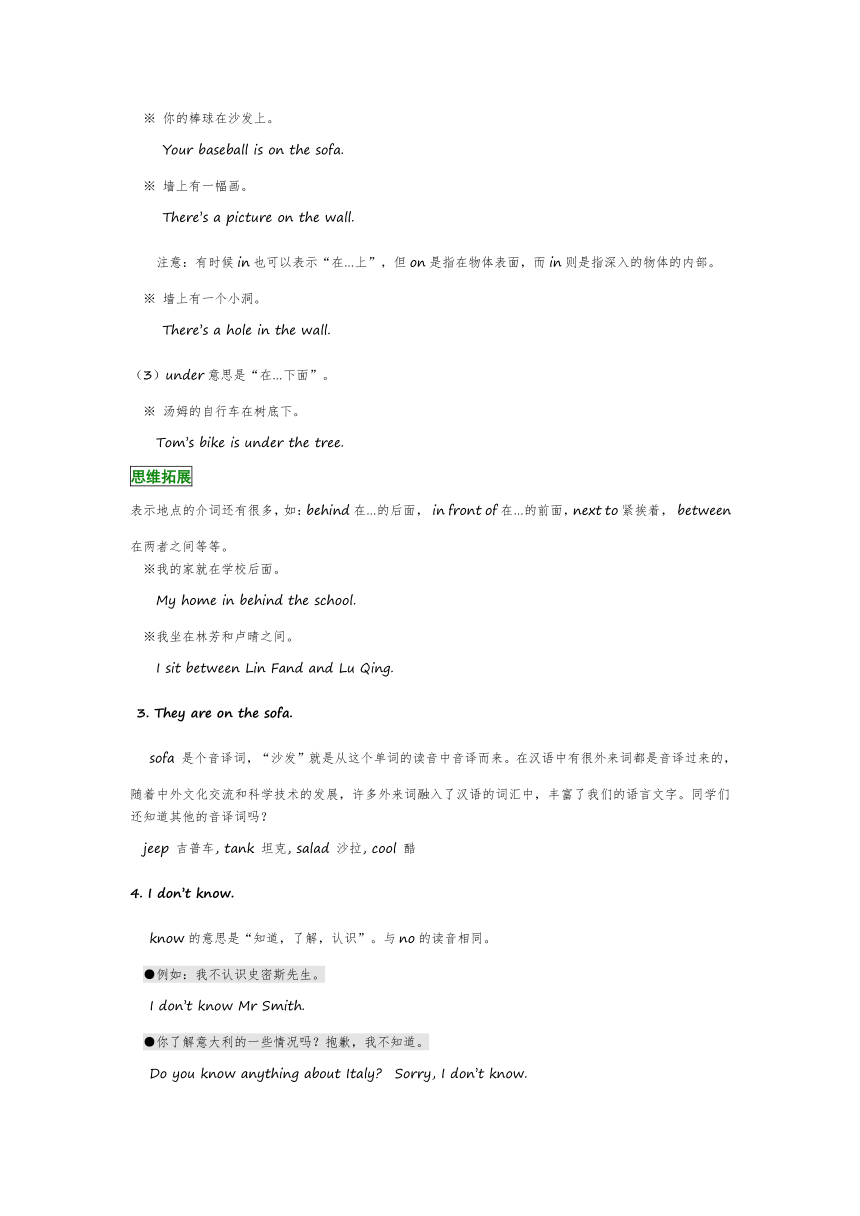
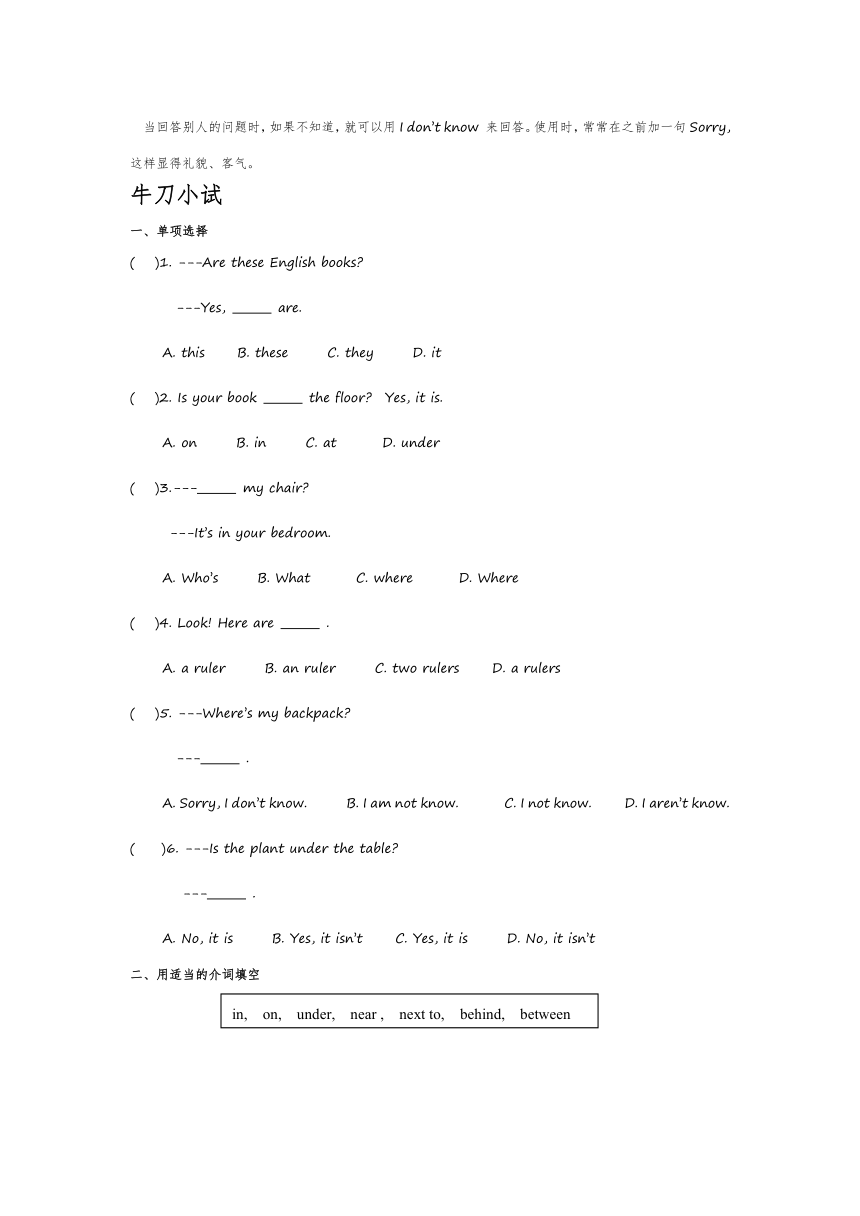
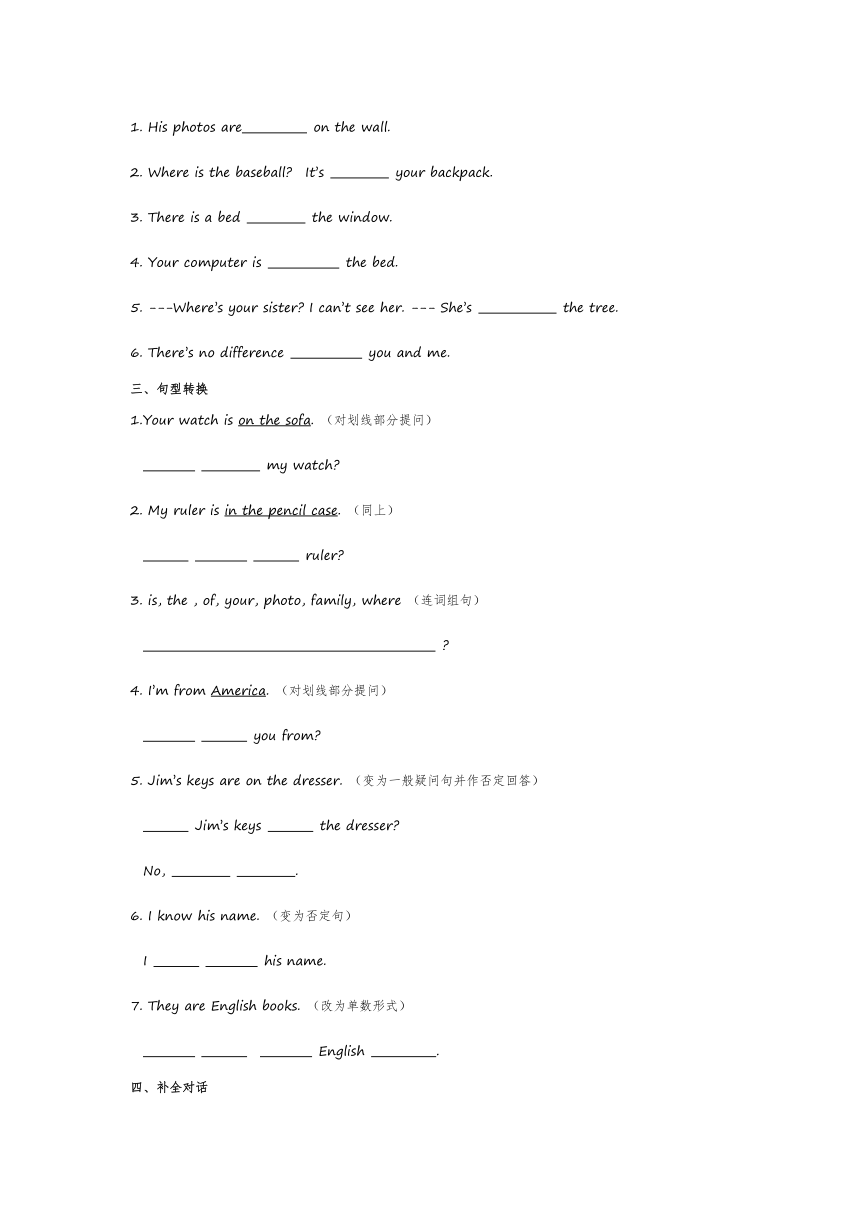
文档简介
Unit 7 Where’s my backpack?
Section A
重点短语
1. my backpack 我的背包
2. on the sofa 在沙发上
3. under the table 在桌子底下
4. in the backpack 在背包里
经典句型
1.Where’s my backpack? 我的背包在哪里?
2. It’s under the table. 它在桌子底下。
3. They’re on the sofa. 他们在沙发上。
4. It’s in the backpack. 它在背包里。
5. Is the baseball on the sofa? No, it isn’t. 棒球在沙发上吗? 不,不在。
6. I don’t know.
学海拾贝
1. Where’s my backpack?
Where + be+主语(人或物)?是询问人或物在什么地方的句型。Where是表示地点的疑问副词,用来引导对地点提问的特殊疑问句。回答时,不用yes或no,而要用表示位置的介词短语来回答。当主语是单数时,be用is; 当主语是复数时,be用are。
●例如:露茜现在在哪里?她在学校。
Where is Lucy now? She’s at school.
●我的钥匙在哪里?在抽屉里。
Where are my keys? They are in the draw
思维拓展
特殊疑问句是指以特殊疑问词引导的问句。其结构为:特殊疑问词+一般疑问句。特殊疑问词一般有what, who, where, which, whose, how, how many, how much, what time等等。
那个人是谁? Who’s that man?
这个背包多少钱?How much is this backpack?
在练习题中,要求对划线部分提问就是将陈述句变为特殊疑问句。关键要选好与划线部分相应的特殊疑问词放在句首,然后将句子变为一般问句放在特殊疑问词后。
※ My book is under the table. (对划线部分提问)
Where is my book?
※ There are 40 students in my class. (同上)
How many students are there in your class?
2. It’s under the table.
(1)table意思是“桌子”, at the table意思为“在桌子旁边”;at table意思是“在桌子旁边吃饭”。
●例如:孩子们都坐在桌子旁边。
All the children are sitting at the table.
●孩子们正在桌子旁边吃饭。
The children are at table.
(2)under the table 意思是“在桌子底下”。Under是介词,意思是“在…的下面”。英语中表示某人或某物在某个地方,常用介词短语来表示。本单元我们所学的in, on, under都是介词,它们与名词构成介词短语来表示东西或人的位置。
特别提示
这三个介词都可以表示地点,其具体用法如下:
(1)in 表示地点时,意思是“在…里面,在…中”;还可以跟大范围的地方,如国家、城市等。
※ 袜子在抽屉里。
The socks are in the drawer.
※ 吉姆和他的父母在北京。
Jim and his parents are in Beijing now.
(2)on表示“在…的上面,在…之上”,物体的表面是接触的。
※ 你的棒球在沙发上。
Your baseball is on the sofa.
※ 墙上有一幅画。
There’s a picture on the wall.
注意:有时候in也可以表示“在…上”,但on是指在物体表面,而in则是指深入的物体的内部。
※ 墙上有一个小洞。
There’s a hole in the wall.
(3)under意思是“在…下面”。
※ 汤姆的自行车在树底下。
Tom’s bike is under the tree.
思维拓展
表示地点的介词还有很多,如:behind在…的后面, in front of在…的前面,next to紧挨着, between在两者之间等等。
※我的家就在学校后面。
My home in behind the school.
※我坐在林芳和卢晴之间。
I sit between Lin Fand and Lu Qing.
3. They are on the sofa.
sofa 是个音译词,“沙发”就是从这个单词的读音中音译而来。在汉语中有很外来词都是音译过来的,随着中外文化交流和科学技术的发展,许多外来词融入了汉语的词汇中,丰富了我们的语言文字。同学们还知道其他的音译词吗?
jeep 吉普车, tank 坦克, salad 沙拉, cool 酷
4. I don’t know.
know的意思是“知道,了解,认识”。与no的读音相同。
●例如:我不认识史密斯先生。
I don’t know Mr Smith.
●你了解意大利的一些情况吗?抱歉,我不知道。
Do you know anything about Italy? Sorry, I don’t know.
当回答别人的问题时,如果不知道,就可以用I don’t know 来回答。使用时,常常在之前加一句Sorry,这样显得礼貌、客气。
牛刀小试
一、单项选择
( )1. ---Are these English books?
---Yes, are.
A. this B. these C. they D. it
( )2. Is your book the floor? Yes, it is.
A. on B. in C. at D. under
( )3.--- my chair?
---It’s in your bedroom.
A. Who’s B. What C. where D. Where
( )4. Look! Here are .
A. a ruler B. an ruler C. two rulers D. a rulers
( )5. ---Where’s my backpack?
--- .
A. Sorry, I don’t know. B. I am not know. C. I not know. D. I aren’t know.
( )6. ---Is the plant under the table?
--- .
A. No, it is B. Yes, it isn’t C. Yes, it is D. No, it isn’t
二、用适当的介词填空
1. His photos are on the wall.
2. Where is the baseball? It’s your backpack.
3. There is a bed the window.
4. Your computer is the bed.
5. ---Where’s your sister? I can’t see her. --- She’s the tree.
6. There’s no difference you and me.
三、句型转换
1.Your watch is on the sofa. (对划线部分提问)
my watch?
2. My ruler is in the pencil case. (同上)
ruler?
3. is, the , of, your, photo, family, where (连词组句)
?
4. I’m from America. (对划线部分提问)
you from?
5. Jim’s keys are on the dresser. (变为一般疑问句并作否定回答)
Jim’s keys the dresser?
No, .
6. I know his name. (变为否定句)
I his name.
7. They are English books. (改为单数形式)
English .
四、补全对话
1. A: What’s in the case?
B: Sorry, I .
2. A:Where the keys? they on the sofa?
B: No, . They are on the dresser.
3. A: What’s this ?
B: It’s a clock.
A: Can you it?
B: Yes. C-L-O-C-K.
A: Thank you.
中考连接
( )1.Look! Some apples are the tree and some birds are the tree.
A. in ; in B. on; on C. in/ on D. on/ in
( )2. “ did you go?”
“To my neighbors…”
A. When B. Where C. How D. Why
( )3. There are many in the basket.
A. tomatoes B. tomatos D. tomato D. tomatose
( )4. --- is your mother, Tina?
---She’s cooking in the kitchen.
A. When B. What C. Where D. How
创新全解
一、1---6 C A D C A C
二、1. on 2. in, 3. near 4. under 5. behind 6. between
三、1. Where’s , my 2. Where, is, your 3. Where is the photo of your family?
4. Where, are 5. Are, on; they , aren’t 6. don’t, know 7. This , is , an, book
四、1. don’t know 2. are, Are; they aren’t 3. in English, spell
超越自我答案
1.D (根据英语表达习惯,属于树本身的东西在树上用on the tree;物体落在树上,也就是不属于树本身的东西在树上要用 in the tree。)
2. B(根据回答说“我去邻居家……”,问句应该是“你去哪儿了?”,故答案应为B. Where)
3. A(句中的be动词用的are,而且还有many修饰可数名词的复数形式,故回答应该为tomato的复数形式tomatoes)
4. C(根据回答说“她在厨房做饭”,可推测问句“你的妈妈在哪里”,故答案应该是C. Where)
Section B
重点短语
1.math book 数学书
2. alarm clock 闹钟
3. computer game 电脑游戏
4. video tape 录像带
5. take these things to your sister把这些东西拿给你的妹妹
6. these things 这些东西
7. bring some things to school 把一些东西拿到学校来
经典句型
1. Please take these things to your sister. 请把这些东西拿给你的妹妹。
2. Can you bring some things to school? 你能把一些东西拿到学校来吗?
3. I need my hat, my notebook, and a pen. 我需要我的帽子、笔记本和钢笔。
4. The notebook in on the floor. 笔记本在地板上。
学海拾贝
◆1. Please take these things to your sister.
take…to…把…拿到…去; 把…拿去给某人
●例如:请把这些书拿到教室里去。
Please take these books to the classroom.
●把这本数学书拿给史密斯先生。
Take this math book to Mr. Smith.
●我爸爸经常带我去动物园。
My father often takes me to the zoo.
特别提示
take…to+地点, 如果地点是home或there,则省略介词to.
I can’t find my way. Can you take me home? 我迷路了。你能带我回家吗?
You can’t take these things there. 你不能把这些东西拿到那儿去。
◆2. Can you bring some things to school?
(1)some的意思是“一些,若干”。它是形容词,可以修饰名词,它既可以修饰可数名词,也可以修饰不可数名词。当它修饰的名词是可数名词时,必须用可数名词的复数形式。
●例如:我有一些关于动物的书。
I have some books about animals.
●请给我拿些水来。
Please get me some water.
思维拓展
(1) some一般用在肯定句中,在否定句和疑问句中,some要变为any。
※ I have some good friends. (变为否定句)
I don’t have any books about animals.
※ There is some water in the glass. (变为一般疑问句)
Is there any water in the glass?
(2) 在有些时候,some 也可用于疑问句。
①向对方发出邀请,并希望对方作出肯定回答时。
※ Would you like some water? 喝点水吧?
②向对方委婉、客气地提出要求或建议。
※ Shall we have a rest and eat some bread? 我们休息一下,吃点面包怎么样?
③委婉地请求别人帮助并希望得到肯定回答时。
※ Could you give me some help? 你能帮我一下吗?
④ 说话人表示反问时。
※ Don’t you often give your son some money? 你不是经常给你儿子钱吗?
(2)bring…to…把…拿到…来;把…拿来给某人
●例如:明天把你的家庭照片拿到学校来。
Bring your family photos to school tomorrow.
●妈妈,请您把我的英语课本拿来给我。
Mum, please bring my English book to me.
把某物拿给某人也可用这种表达:bring sb. sth.
●例如:你能给我拿些水来吗?
Could you bring me some water?
特别提示
bring…to +地点, 如果地点是home或here,则省略介词to.
Don’t bring your friends home. 不要把你的朋友带到家里来。
Bring the new students here to my office. 把新同学带到办公室来。
方法指津:take 与 bring
take表示把某物或某人带到某处去,含有远离说话的地方的意思,强调方向性;而bring表示将某物或某人从别处带(拿)来,也强调方向性。
take拿走;拿去
bring拿来
◆3. I need my hat, my notebook, and a pen.
need意思是“需要”。可作实义动词、情态动词和名词。
(1)need作为实义动词时,后面跟名词或代词作宾语,也可以跟不定式to do,意思是“需要去做某事”;也可以跟doing形式,表示被动,意思是“需要被…”。
●例如:我需要你的帮助。
I need your help.
●我需要去看医生。
I need to see a doctor.
●这台电脑需要修理一下了。
This computer needs mending.
(2)need也可做为情态动词。情态动词没有人称和数的变化,不能独立作谓语,必须与后面的动词原形共同构成谓语。need作为情态动词时,常用于否定句和疑问句中。
●例如:你不需要做所有的工作。
You needn’t do all the work.
用need引导的问句做答时,肯定回答用must, 否定回答用needn’t。
●我现在需要打扫房间吗?
Need I clean my room now?
●是的,你必须现在打扫。
Yes, you must.
●不,你不必现在打扫。
No, you needn’t.
(3)need用做名词,意思也是“需要”。可用于短语in need of…“需要…”。
●例如:他们现在急需清洁工。
They are in great need of cleaners.
◆4. The notebook is on the floor.
这句话的意思是“笔记本在地板上”。主语+be+表位置的介词短语,意思是“某物/某人在某处”。
●例如:我的钥匙在抽屉里。
My keys are in the drawer.
思维拓展
表达“在某处有某人/某物”还可以用There be句型。There be句型是个倒装句,在日常生活中使用非常广泛。它的句型结构为 “There + be(is, are) + 名词+ 介词短语”。
※ There is a book on the desk. 桌子上有一本书。
※ There are 40 students in my class. 我们班有40个学生。
其疑问句形式是将be提前:Be (Is , Are) + there + 名词+介词短语。意为“在某处有某人/某物吗?回答用“Yes, there + be” 或 “No, there +be +not”。
※ Is there a book on the desk? 桌子上有一本书吧?
Yes, there is. / No, there isn’t. 是的,有一本。/ 不,没有。
※ Are there any students in the classroom? 教室里有学生吗?
Yes, there are. / No, there aren’t. 是的,有一些。/ 不,没有。
其否定形式是There +be +not+名词+介词短语。
※ There isn’t a book on the desk. 桌子上没有书。
※ There aren’t any students in the classroom. 教室里没有学生。
特别提示
There be句型遵循一个原则:就近原则。就是说be动词要根据离它最近的那个名词的形式来变化。如果紧挨be动词的名词是单数形式或不可数名词,be就用单数形式is 或was;如果紧挨be动词的名词是复数形式,则be就用其复数形式are 或were。
※ There is a ruler and two books on the table. 桌子上有一把尺子和两本书。
※ There are two books and a ruler on the table. 桌子上有两本书和一把尺子。
牛刀小试
一、用适当的介词填空
1. The books are the bed.
2. The birds are the tree.
3. There are some apples the tree.
4. The football is the chair.
5. My home is the school.
6. What’s this English?
7. Please call Mary 236-759.
8. You can’t see the cat because it’s the door.
9. His jacket is the case.
10. I sit Lucy and Lily.
二、单项选择
( )1. ---Is your book the floor? ---Yes, it is.
A. on B. in C. at D. under
( )2. Mum, can you my book school?
A. take, to B. bring, to C. bring, in D. take, in
( )3. There an apple and some oranges on the table.
A. am B. is C. are D. have
( )4. My computer is in room.
A. a B. an C. he’s D. the
( )5. ---What’s on the floor? ---There is .
A. a book and a baseball and some CDs.
B. a book, a baseball, some CDs.
C. a book, a baseball and some CDs.
D. a book, a baseball or some CDs.
( )6. I need the hat to my sister.
A. take B. bring C. to take D. to bring
( )7. Are there on the table?
A. some bananas B. some banana C. any banana D. any bananas
三、连词组句
1. you, those, to, school, can, bring, things
?
2. is, where, your, alarm clock
?
3. can, spell, the boy, name, his
.
4. take, please, video tape, to ,your, father, these
.
5. the chair, on, is, the floor, between, the bed, the desk, and
.
四、翻译句子
1. 我的书在哪里? 在沙发上。
are my books? the sofa.
2. 请把这些东西带给你的妹妹。
Please these your sister.
3. 很抱歉,我不知道。
I’m sorry I .
4. 他需要一些牛奶。
He milk.
5. 明天你能把你的全家福带到学校来吗?
Can you your school tomorrow?
6. 桌子上有一个闹钟。
alarm clock the desk.
中考连接
( )1.It’s a beautiful ,sunny day! There many people here on vacation.
A. be B. am C. is D. are
( )2. ---Excuse me, the park?
---It’s on the Center Street.
A. What B. Which C. How D. Where
( )3. --- are you going this summer holiday?
--- To Beijing.
A. When B. Where C. How D. Why
( )4. There is some water in that bottle, isn’t ?
A. there B. it C. that
创新全解
一、
1. on 2. in 3. on 4. under 5. near 6. in 7. at 8. behind 9. in 10. between
二、1---5 A B B D C 6---7 C D
三、
1. Where, They are on 2. take, things to 3. don’t know 4. needs some
5. bring, family photos to 6. There is an, on
四、1. Can you bring those things to school?
2. Where is your alarm clock?
3. The boy can spell his name.
4. Please take these video tapes to your father.
5. The chair is on the floor between the bed and the desk.
中考连接答案
1. D (些句考查There be句型,横线后面是many people,名词复数形式,所以用D. are)
2. D (根据回答“在中心街上”,回答的是地点,所以疑问词应该是Where,“在哪里”)
3. B (些句想表达“你今年暑假你去哪里?”故用Where)
4. A (该句为前肯后否的反意疑问句,在there be句型中,构成疑问句时用there, 故答案为A. there)Self Check
重点单词
◆1. table 名词,意思是“桌子”。
●例如:桌子上有一些水果。
There are some fruit on the table.
特别提示
table 与desk
两者都有“桌子”的意思,但table侧重于供吃饭、喝茶或其他用途的桌子,通常不带有抽屉;而desk侧重于供读书、写字、办公用的桌子,一般都带有抽屉。
※ ---Where’s my math book? 我数学课本呢?
---It’s on the desk. 在书桌上呢。
※ The Greens are having dinner at table. 格林一家正在桌子边吃饭。
◆2. hat 名词,意思是“帽子”。
●例如:她载着一顶漂亮的帽子。
She wears a beautiful hat.
比较:hat与cap
hat一般指有沿的帽子,像妇女儿童的宽边帽;cap则一般指鸭舌帽。
●例如:那个戴帽子的女孩子是我的妹妹。
The girl in a hat is my sister.
●那个男孩子戴了一顶帽子。
The boy wears a cap.
◆3. dresser名词,意思是“梳妆台;碗柜”。
它是由名词dress(衣服)加构成名词的后缀-er构成的。类似的词还有:
draw(拖;拉)+er= drawer(抽屉)
cook(做饭)+ er=cooker(炊具)
wash(洗)+ er= washer(洗衣机)
Just for fun
说明:背书包的小精灵在卧室、厨房中到处找自己的书包。最后,书包却原来在自己的背上(It’s on your back)。
牛刀小试
一、用划线词的反义词或对应词填空
1. Her name is Li Yuchun. name is Liu Xiang.
2. These are oranges and are apples.
3. He is Jim and is Mary.
4. This is my father. That is my .
5. The book is on the desk and the baseball is the desk.
6. His first name is John,and his name is Brown.
7. your pictures here. Take the books there.
8. Linda is my , and Clark is my uncle.
9. Ask and these questions.
10. The parents have a son and a .
二、单项选择
( )1. Is your photo in the drawer? .
A. Yes, I am B. No,it is C. Yes,it is D. No,I’m not
( )2. --- my baseball?
---It’s under the chair.
A. Where B. Where’s C. Where’re D. Where are
( )3. --- under the tree?
---No,they aren’t. A. Where are B. What is C. Are they D. Is it
( )4. Where are your brothers? .
A. He is at home B. He is in his room
??? C. Yes,they are D. I don’t know
( )5. There a computer on the desk.
A. are B. have C. has D. is
三、句型转换
1. We are in Beijing. (就划线部分提问)
we?
2. Can you bring the ruler to me? (否定回答)
No, .
3. I draw pictures on the wall. (变为否定句)
I pictures on the wall.
4. We have two new students in our class. (变为同义句)
two new students in our class.
5. There’s an English book in the desk. (变为复数句)
English in the desks.
四、补全对话
A. Yes!
B. The keys? They’re on the table.
C. No, they aren’t.
D. How about my books?
E. It’s under the sofa.
A: Hey, Susan!
B: 1 .
A: Is my computer game on the table?
B: No, it isn’t. It’s on the bookcase.
A: Oh, OK. 2 . Are they on the bookcase, too?
B: 3 . They’re on the chair.
A: Oh. So, where is my pencil case?
B: 4 .
A: And where’s my backpack?
B: It’s under the table. And your baseball is under the chair.
A: Oh, OK. And where are Mom’s keys?
B: 5 .
创新全解
牛刀小试版块答案:
一、1. His 2. those 3. she 4. mother 5. under
6. last 7. Bring 8. aunt 9. answer 10. daughter
二、1. Where are 2. I can’t 3. don’t draw 4. There are 5. There are books
三、1. A 2. D 3. C 4. E 5. B
有趣的“手拉手”英语
hand in hand 手拉手
arm in arm 臂挽臂
face to face 脸对脸
ear to ear 咧着嘴
day after day 日复一日
foot by foot 一步一步地
neck and neck 齐头并进
one by one 一个接一个
house to house 挨家挨户
again and again 再三地,反复地
little by little 逐渐地,一点一点地
side by side 肩并肩地
time to time 不时地
Section A
重点短语
1. my backpack 我的背包
2. on the sofa 在沙发上
3. under the table 在桌子底下
4. in the backpack 在背包里
经典句型
1.Where’s my backpack? 我的背包在哪里?
2. It’s under the table. 它在桌子底下。
3. They’re on the sofa. 他们在沙发上。
4. It’s in the backpack. 它在背包里。
5. Is the baseball on the sofa? No, it isn’t. 棒球在沙发上吗? 不,不在。
6. I don’t know.
学海拾贝
1. Where’s my backpack?
Where + be+主语(人或物)?是询问人或物在什么地方的句型。Where是表示地点的疑问副词,用来引导对地点提问的特殊疑问句。回答时,不用yes或no,而要用表示位置的介词短语来回答。当主语是单数时,be用is; 当主语是复数时,be用are。
●例如:露茜现在在哪里?她在学校。
Where is Lucy now? She’s at school.
●我的钥匙在哪里?在抽屉里。
Where are my keys? They are in the draw
思维拓展
特殊疑问句是指以特殊疑问词引导的问句。其结构为:特殊疑问词+一般疑问句。特殊疑问词一般有what, who, where, which, whose, how, how many, how much, what time等等。
那个人是谁? Who’s that man?
这个背包多少钱?How much is this backpack?
在练习题中,要求对划线部分提问就是将陈述句变为特殊疑问句。关键要选好与划线部分相应的特殊疑问词放在句首,然后将句子变为一般问句放在特殊疑问词后。
※ My book is under the table. (对划线部分提问)
Where is my book?
※ There are 40 students in my class. (同上)
How many students are there in your class?
2. It’s under the table.
(1)table意思是“桌子”, at the table意思为“在桌子旁边”;at table意思是“在桌子旁边吃饭”。
●例如:孩子们都坐在桌子旁边。
All the children are sitting at the table.
●孩子们正在桌子旁边吃饭。
The children are at table.
(2)under the table 意思是“在桌子底下”。Under是介词,意思是“在…的下面”。英语中表示某人或某物在某个地方,常用介词短语来表示。本单元我们所学的in, on, under都是介词,它们与名词构成介词短语来表示东西或人的位置。
特别提示
这三个介词都可以表示地点,其具体用法如下:
(1)in 表示地点时,意思是“在…里面,在…中”;还可以跟大范围的地方,如国家、城市等。
※ 袜子在抽屉里。
The socks are in the drawer.
※ 吉姆和他的父母在北京。
Jim and his parents are in Beijing now.
(2)on表示“在…的上面,在…之上”,物体的表面是接触的。
※ 你的棒球在沙发上。
Your baseball is on the sofa.
※ 墙上有一幅画。
There’s a picture on the wall.
注意:有时候in也可以表示“在…上”,但on是指在物体表面,而in则是指深入的物体的内部。
※ 墙上有一个小洞。
There’s a hole in the wall.
(3)under意思是“在…下面”。
※ 汤姆的自行车在树底下。
Tom’s bike is under the tree.
思维拓展
表示地点的介词还有很多,如:behind在…的后面, in front of在…的前面,next to紧挨着, between在两者之间等等。
※我的家就在学校后面。
My home in behind the school.
※我坐在林芳和卢晴之间。
I sit between Lin Fand and Lu Qing.
3. They are on the sofa.
sofa 是个音译词,“沙发”就是从这个单词的读音中音译而来。在汉语中有很外来词都是音译过来的,随着中外文化交流和科学技术的发展,许多外来词融入了汉语的词汇中,丰富了我们的语言文字。同学们还知道其他的音译词吗?
jeep 吉普车, tank 坦克, salad 沙拉, cool 酷
4. I don’t know.
know的意思是“知道,了解,认识”。与no的读音相同。
●例如:我不认识史密斯先生。
I don’t know Mr Smith.
●你了解意大利的一些情况吗?抱歉,我不知道。
Do you know anything about Italy? Sorry, I don’t know.
当回答别人的问题时,如果不知道,就可以用I don’t know 来回答。使用时,常常在之前加一句Sorry,这样显得礼貌、客气。
牛刀小试
一、单项选择
( )1. ---Are these English books?
---Yes, are.
A. this B. these C. they D. it
( )2. Is your book the floor? Yes, it is.
A. on B. in C. at D. under
( )3.--- my chair?
---It’s in your bedroom.
A. Who’s B. What C. where D. Where
( )4. Look! Here are .
A. a ruler B. an ruler C. two rulers D. a rulers
( )5. ---Where’s my backpack?
--- .
A. Sorry, I don’t know. B. I am not know. C. I not know. D. I aren’t know.
( )6. ---Is the plant under the table?
--- .
A. No, it is B. Yes, it isn’t C. Yes, it is D. No, it isn’t
二、用适当的介词填空
1. His photos are on the wall.
2. Where is the baseball? It’s your backpack.
3. There is a bed the window.
4. Your computer is the bed.
5. ---Where’s your sister? I can’t see her. --- She’s the tree.
6. There’s no difference you and me.
三、句型转换
1.Your watch is on the sofa. (对划线部分提问)
my watch?
2. My ruler is in the pencil case. (同上)
ruler?
3. is, the , of, your, photo, family, where (连词组句)
?
4. I’m from America. (对划线部分提问)
you from?
5. Jim’s keys are on the dresser. (变为一般疑问句并作否定回答)
Jim’s keys the dresser?
No, .
6. I know his name. (变为否定句)
I his name.
7. They are English books. (改为单数形式)
English .
四、补全对话
1. A: What’s in the case?
B: Sorry, I .
2. A:Where the keys? they on the sofa?
B: No, . They are on the dresser.
3. A: What’s this ?
B: It’s a clock.
A: Can you it?
B: Yes. C-L-O-C-K.
A: Thank you.
中考连接
( )1.Look! Some apples are the tree and some birds are the tree.
A. in ; in B. on; on C. in/ on D. on/ in
( )2. “ did you go?”
“To my neighbors…”
A. When B. Where C. How D. Why
( )3. There are many in the basket.
A. tomatoes B. tomatos D. tomato D. tomatose
( )4. --- is your mother, Tina?
---She’s cooking in the kitchen.
A. When B. What C. Where D. How
创新全解
一、1---6 C A D C A C
二、1. on 2. in, 3. near 4. under 5. behind 6. between
三、1. Where’s , my 2. Where, is, your 3. Where is the photo of your family?
4. Where, are 5. Are, on; they , aren’t 6. don’t, know 7. This , is , an, book
四、1. don’t know 2. are, Are; they aren’t 3. in English, spell
超越自我答案
1.D (根据英语表达习惯,属于树本身的东西在树上用on the tree;物体落在树上,也就是不属于树本身的东西在树上要用 in the tree。)
2. B(根据回答说“我去邻居家……”,问句应该是“你去哪儿了?”,故答案应为B. Where)
3. A(句中的be动词用的are,而且还有many修饰可数名词的复数形式,故回答应该为tomato的复数形式tomatoes)
4. C(根据回答说“她在厨房做饭”,可推测问句“你的妈妈在哪里”,故答案应该是C. Where)
Section B
重点短语
1.math book 数学书
2. alarm clock 闹钟
3. computer game 电脑游戏
4. video tape 录像带
5. take these things to your sister把这些东西拿给你的妹妹
6. these things 这些东西
7. bring some things to school 把一些东西拿到学校来
经典句型
1. Please take these things to your sister. 请把这些东西拿给你的妹妹。
2. Can you bring some things to school? 你能把一些东西拿到学校来吗?
3. I need my hat, my notebook, and a pen. 我需要我的帽子、笔记本和钢笔。
4. The notebook in on the floor. 笔记本在地板上。
学海拾贝
◆1. Please take these things to your sister.
take…to…把…拿到…去; 把…拿去给某人
●例如:请把这些书拿到教室里去。
Please take these books to the classroom.
●把这本数学书拿给史密斯先生。
Take this math book to Mr. Smith.
●我爸爸经常带我去动物园。
My father often takes me to the zoo.
特别提示
take…to+地点, 如果地点是home或there,则省略介词to.
I can’t find my way. Can you take me home? 我迷路了。你能带我回家吗?
You can’t take these things there. 你不能把这些东西拿到那儿去。
◆2. Can you bring some things to school?
(1)some的意思是“一些,若干”。它是形容词,可以修饰名词,它既可以修饰可数名词,也可以修饰不可数名词。当它修饰的名词是可数名词时,必须用可数名词的复数形式。
●例如:我有一些关于动物的书。
I have some books about animals.
●请给我拿些水来。
Please get me some water.
思维拓展
(1) some一般用在肯定句中,在否定句和疑问句中,some要变为any。
※ I have some good friends. (变为否定句)
I don’t have any books about animals.
※ There is some water in the glass. (变为一般疑问句)
Is there any water in the glass?
(2) 在有些时候,some 也可用于疑问句。
①向对方发出邀请,并希望对方作出肯定回答时。
※ Would you like some water? 喝点水吧?
②向对方委婉、客气地提出要求或建议。
※ Shall we have a rest and eat some bread? 我们休息一下,吃点面包怎么样?
③委婉地请求别人帮助并希望得到肯定回答时。
※ Could you give me some help? 你能帮我一下吗?
④ 说话人表示反问时。
※ Don’t you often give your son some money? 你不是经常给你儿子钱吗?
(2)bring…to…把…拿到…来;把…拿来给某人
●例如:明天把你的家庭照片拿到学校来。
Bring your family photos to school tomorrow.
●妈妈,请您把我的英语课本拿来给我。
Mum, please bring my English book to me.
把某物拿给某人也可用这种表达:bring sb. sth.
●例如:你能给我拿些水来吗?
Could you bring me some water?
特别提示
bring…to +地点, 如果地点是home或here,则省略介词to.
Don’t bring your friends home. 不要把你的朋友带到家里来。
Bring the new students here to my office. 把新同学带到办公室来。
方法指津:take 与 bring
take表示把某物或某人带到某处去,含有远离说话的地方的意思,强调方向性;而bring表示将某物或某人从别处带(拿)来,也强调方向性。
take拿走;拿去
bring拿来
◆3. I need my hat, my notebook, and a pen.
need意思是“需要”。可作实义动词、情态动词和名词。
(1)need作为实义动词时,后面跟名词或代词作宾语,也可以跟不定式to do,意思是“需要去做某事”;也可以跟doing形式,表示被动,意思是“需要被…”。
●例如:我需要你的帮助。
I need your help.
●我需要去看医生。
I need to see a doctor.
●这台电脑需要修理一下了。
This computer needs mending.
(2)need也可做为情态动词。情态动词没有人称和数的变化,不能独立作谓语,必须与后面的动词原形共同构成谓语。need作为情态动词时,常用于否定句和疑问句中。
●例如:你不需要做所有的工作。
You needn’t do all the work.
用need引导的问句做答时,肯定回答用must, 否定回答用needn’t。
●我现在需要打扫房间吗?
Need I clean my room now?
●是的,你必须现在打扫。
Yes, you must.
●不,你不必现在打扫。
No, you needn’t.
(3)need用做名词,意思也是“需要”。可用于短语in need of…“需要…”。
●例如:他们现在急需清洁工。
They are in great need of cleaners.
◆4. The notebook is on the floor.
这句话的意思是“笔记本在地板上”。主语+be+表位置的介词短语,意思是“某物/某人在某处”。
●例如:我的钥匙在抽屉里。
My keys are in the drawer.
思维拓展
表达“在某处有某人/某物”还可以用There be句型。There be句型是个倒装句,在日常生活中使用非常广泛。它的句型结构为 “There + be(is, are) + 名词+ 介词短语”。
※ There is a book on the desk. 桌子上有一本书。
※ There are 40 students in my class. 我们班有40个学生。
其疑问句形式是将be提前:Be (Is , Are) + there + 名词+介词短语。意为“在某处有某人/某物吗?回答用“Yes, there + be” 或 “No, there +be +not”。
※ Is there a book on the desk? 桌子上有一本书吧?
Yes, there is. / No, there isn’t. 是的,有一本。/ 不,没有。
※ Are there any students in the classroom? 教室里有学生吗?
Yes, there are. / No, there aren’t. 是的,有一些。/ 不,没有。
其否定形式是There +be +not+名词+介词短语。
※ There isn’t a book on the desk. 桌子上没有书。
※ There aren’t any students in the classroom. 教室里没有学生。
特别提示
There be句型遵循一个原则:就近原则。就是说be动词要根据离它最近的那个名词的形式来变化。如果紧挨be动词的名词是单数形式或不可数名词,be就用单数形式is 或was;如果紧挨be动词的名词是复数形式,则be就用其复数形式are 或were。
※ There is a ruler and two books on the table. 桌子上有一把尺子和两本书。
※ There are two books and a ruler on the table. 桌子上有两本书和一把尺子。
牛刀小试
一、用适当的介词填空
1. The books are the bed.
2. The birds are the tree.
3. There are some apples the tree.
4. The football is the chair.
5. My home is the school.
6. What’s this English?
7. Please call Mary 236-759.
8. You can’t see the cat because it’s the door.
9. His jacket is the case.
10. I sit Lucy and Lily.
二、单项选择
( )1. ---Is your book the floor? ---Yes, it is.
A. on B. in C. at D. under
( )2. Mum, can you my book school?
A. take, to B. bring, to C. bring, in D. take, in
( )3. There an apple and some oranges on the table.
A. am B. is C. are D. have
( )4. My computer is in room.
A. a B. an C. he’s D. the
( )5. ---What’s on the floor? ---There is .
A. a book and a baseball and some CDs.
B. a book, a baseball, some CDs.
C. a book, a baseball and some CDs.
D. a book, a baseball or some CDs.
( )6. I need the hat to my sister.
A. take B. bring C. to take D. to bring
( )7. Are there on the table?
A. some bananas B. some banana C. any banana D. any bananas
三、连词组句
1. you, those, to, school, can, bring, things
?
2. is, where, your, alarm clock
?
3. can, spell, the boy, name, his
.
4. take, please, video tape, to ,your, father, these
.
5. the chair, on, is, the floor, between, the bed, the desk, and
.
四、翻译句子
1. 我的书在哪里? 在沙发上。
are my books? the sofa.
2. 请把这些东西带给你的妹妹。
Please these your sister.
3. 很抱歉,我不知道。
I’m sorry I .
4. 他需要一些牛奶。
He milk.
5. 明天你能把你的全家福带到学校来吗?
Can you your school tomorrow?
6. 桌子上有一个闹钟。
alarm clock the desk.
中考连接
( )1.It’s a beautiful ,sunny day! There many people here on vacation.
A. be B. am C. is D. are
( )2. ---Excuse me, the park?
---It’s on the Center Street.
A. What B. Which C. How D. Where
( )3. --- are you going this summer holiday?
--- To Beijing.
A. When B. Where C. How D. Why
( )4. There is some water in that bottle, isn’t ?
A. there B. it C. that
创新全解
一、
1. on 2. in 3. on 4. under 5. near 6. in 7. at 8. behind 9. in 10. between
二、1---5 A B B D C 6---7 C D
三、
1. Where, They are on 2. take, things to 3. don’t know 4. needs some
5. bring, family photos to 6. There is an, on
四、1. Can you bring those things to school?
2. Where is your alarm clock?
3. The boy can spell his name.
4. Please take these video tapes to your father.
5. The chair is on the floor between the bed and the desk.
中考连接答案
1. D (些句考查There be句型,横线后面是many people,名词复数形式,所以用D. are)
2. D (根据回答“在中心街上”,回答的是地点,所以疑问词应该是Where,“在哪里”)
3. B (些句想表达“你今年暑假你去哪里?”故用Where)
4. A (该句为前肯后否的反意疑问句,在there be句型中,构成疑问句时用there, 故答案为A. there)Self Check
重点单词
◆1. table 名词,意思是“桌子”。
●例如:桌子上有一些水果。
There are some fruit on the table.
特别提示
table 与desk
两者都有“桌子”的意思,但table侧重于供吃饭、喝茶或其他用途的桌子,通常不带有抽屉;而desk侧重于供读书、写字、办公用的桌子,一般都带有抽屉。
※ ---Where’s my math book? 我数学课本呢?
---It’s on the desk. 在书桌上呢。
※ The Greens are having dinner at table. 格林一家正在桌子边吃饭。
◆2. hat 名词,意思是“帽子”。
●例如:她载着一顶漂亮的帽子。
She wears a beautiful hat.
比较:hat与cap
hat一般指有沿的帽子,像妇女儿童的宽边帽;cap则一般指鸭舌帽。
●例如:那个戴帽子的女孩子是我的妹妹。
The girl in a hat is my sister.
●那个男孩子戴了一顶帽子。
The boy wears a cap.
◆3. dresser名词,意思是“梳妆台;碗柜”。
它是由名词dress(衣服)加构成名词的后缀-er构成的。类似的词还有:
draw(拖;拉)+er= drawer(抽屉)
cook(做饭)+ er=cooker(炊具)
wash(洗)+ er= washer(洗衣机)
Just for fun
说明:背书包的小精灵在卧室、厨房中到处找自己的书包。最后,书包却原来在自己的背上(It’s on your back)。
牛刀小试
一、用划线词的反义词或对应词填空
1. Her name is Li Yuchun. name is Liu Xiang.
2. These are oranges and are apples.
3. He is Jim and is Mary.
4. This is my father. That is my .
5. The book is on the desk and the baseball is the desk.
6. His first name is John,and his name is Brown.
7. your pictures here. Take the books there.
8. Linda is my , and Clark is my uncle.
9. Ask and these questions.
10. The parents have a son and a .
二、单项选择
( )1. Is your photo in the drawer? .
A. Yes, I am B. No,it is C. Yes,it is D. No,I’m not
( )2. --- my baseball?
---It’s under the chair.
A. Where B. Where’s C. Where’re D. Where are
( )3. --- under the tree?
---No,they aren’t. A. Where are B. What is C. Are they D. Is it
( )4. Where are your brothers? .
A. He is at home B. He is in his room
??? C. Yes,they are D. I don’t know
( )5. There a computer on the desk.
A. are B. have C. has D. is
三、句型转换
1. We are in Beijing. (就划线部分提问)
we?
2. Can you bring the ruler to me? (否定回答)
No, .
3. I draw pictures on the wall. (变为否定句)
I pictures on the wall.
4. We have two new students in our class. (变为同义句)
two new students in our class.
5. There’s an English book in the desk. (变为复数句)
English in the desks.
四、补全对话
A. Yes!
B. The keys? They’re on the table.
C. No, they aren’t.
D. How about my books?
E. It’s under the sofa.
A: Hey, Susan!
B: 1 .
A: Is my computer game on the table?
B: No, it isn’t. It’s on the bookcase.
A: Oh, OK. 2 . Are they on the bookcase, too?
B: 3 . They’re on the chair.
A: Oh. So, where is my pencil case?
B: 4 .
A: And where’s my backpack?
B: It’s under the table. And your baseball is under the chair.
A: Oh, OK. And where are Mom’s keys?
B: 5 .
创新全解
牛刀小试版块答案:
一、1. His 2. those 3. she 4. mother 5. under
6. last 7. Bring 8. aunt 9. answer 10. daughter
二、1. Where are 2. I can’t 3. don’t draw 4. There are 5. There are books
三、1. A 2. D 3. C 4. E 5. B
有趣的“手拉手”英语
hand in hand 手拉手
arm in arm 臂挽臂
face to face 脸对脸
ear to ear 咧着嘴
day after day 日复一日
foot by foot 一步一步地
neck and neck 齐头并进
one by one 一个接一个
house to house 挨家挨户
again and again 再三地,反复地
little by little 逐渐地,一点一点地
side by side 肩并肩地
time to time 不时地
同课章节目录
- Unit 1 Good morning
- Section A
- Section B
- Unit 2 What's this in English?
- Section A
- Section B
- Unit 3 What color is it?
- Section A
- Section B
- Unit 4 My name's is Gina
- Section A
- Section B
- Unit 5 This is my siste
- Section A
- Section B
- Unit 6 Is this your pencil?
- Section A
- Section B
- Unit 7 Where's my schoolbag?
- Section A
- Section B
- Unit 8 Do you have a soccer ball?
- Sectioan A
- Sectioan B
- Unit 9 Do you like bananas?
- Section A
- Section B
- Unit 10 How much are these socks?
- Section A
- Section B
